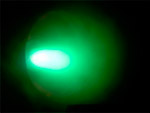Russian scientists have developed a technique that effectively synthesizes Nickel oxide nanoparticles with specified magnetic properties, which allows them to be used as the basis for fast and cost-effective flash memory for new generations of computers. This was reported by the press service of the Russian science Foundation (RPF) with reference to an article in the journal Physica E.
Nanoparticles made of dielectrics and thin strips of some metals, such as gold or silver, have a lot of unusual optical and magnetic properties. This allows them to be used to convert light energy into other types of vibrations, as well as to manipulate their behavior inside the human or animal body, using similar structures to destroy cancer tumors or deliver drugs.
Many of these characteristics of nanoparticles depend primarily not on their composition, but on their size and shape, which are quite difficult to control in the production of nanostructures. Such problems force scientists to constantly search for new methods of nanoparticle synthesisthat are both highly efficient and allow producing structures that are very uniform in size.
Scientists from the Krasnoyarsk research center SB RAS and their colleagues from the Siberian Federal University in Krasnoyarsk developed a technique with similar properties by experimenting with nanoparticles based on Nickel oxide, a relatively cheap metal found everywhere on Earth.
This material is of interest to physicists and materials scientists because it allows the creation of so-called antiferromagnetic nanoparticles. This is what researchers call a special class of materials in which the magnetic moments of atoms are not directed in one direction, as in conventional magnets, but are stacked in a "staggered" order. As a result, they neutralize each other and do not create an external magnetic field.
Such" packaging " of atoms allows the use of antiferromagnetic materials for super-dense recording of information, but this requires creating technologies that allow cheap production of Nickel oxide nanoparticles with clearly verified sizes, shapes, and other characteristics.
Russian scientists have discovered that this can be achieved by passing a high-power current through a Nickel filament located inside a special reactor where pure oxygen is supplied. This process leads to the formation of plasma around the electrode, which begins to interact with its matter and form nanoparticles, whose magnetic properties can be controlled and changed directly during their formation by manipulating the rate of gas ionization.
Thanks to this, it is possible to obtain nanoparticlesadapted to solve a variety of tasks, including creating memory for future computers, various catalysts and sensors. Scientists hope that their technology will accelerate the development of all these devices and become their basis in the coming years.

